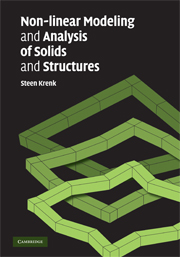Book contents
2 - Non-linear bar elements
Published online by Cambridge University Press: 05 June 2012
Summary
The finite element method has been the method of choice for modeling and analysis of structures and solids for several decades. The basic idea is that the structure (or solid) is considered as an assembly of elements, and that each element is modeled in a standard format that permits repetitive use of the individual element formats. Bar elements only contain a single internal degree of freedom – the elongation – and they are therefore a convenient means for introducing and illustrating the basic features of geometrically non-linear finite element analysis.
In a geometrically non-linear problem the first question to arise is the definition of a non-linear measure of deformation, the strain. This is addressed in Section 2.1. When a structure is assembled from the individual elements, use is generally made of the principle of virtual work. The principle of virtual work is a restatement of the equilibrium equations in scalar form. It turns out that once a non-linear strain definition has been adopted, the corresponding definition of stress follows from the formulation of the principle of virtual work. This is the subject of Section 2.2. The tangent stiffness matrix of a geometrically non-linear bar element is derived in Section 2.3 in global coordinates.
The derivation of the equilibrium and stiffness relations of the bar element is quite simple because the strain is constant within the element. In order to illustrate the relation to more complex problems involving other types of elements, the tangent stiffness matrix is re-derived by use of shape functions in global coordinates.
Information
- Type
- Chapter
- Information
- Publisher: Cambridge University PressPrint publication year: 2009
